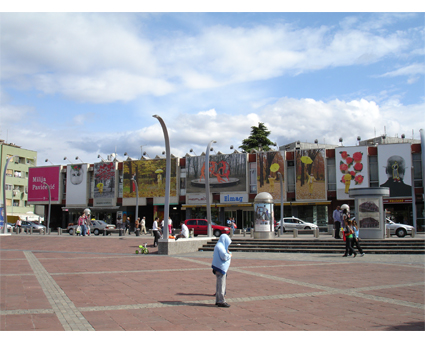Interview with Mirjana Dabović Pejović
Art historian, curator of the Atelier DADO Gallery National Museum of Montenegro, Cetinje
Cetinje, September 2008
MIRJANA DABOVIC’ PEJOVIC’ – The city of Cetinje, which is over 500 years old, has a strong historical heritage. The city was a royal capital, and the reign of the last king, Nikola (who
ruled Montenegro for over 50 years), was a period of great expansion for the city. During that time, in the late 19th century, the city acquired a royal theatre, the new prince’s residence, the Girls’ Institute, a modern hospital, a post office... After World War I, the Montenegrin kingdom become part of Yugoslavia, and later the capital was moved to Podgorica, after which the city began its slow decline. In more recent history, at the beginning of the ’90s, the general situation was again changing. The crisis and the war atmosphere in neighbouring countries affected the
social circumstances, and the city, like the rest of the country, has been facing long stagnation. But as a city with strong historical roots, it has preserved the spirit of the old royal capital. Nowadays, this is still visible in institutions such as the National Museum of Montenegro, the National Archive, and the Central Library, and great efforts have been made in recent years to change its economical situation. With regard to the development of contemporary art in Montenegro, it generally started to change in the late ’80s, and one of the most important steps was the foundation of three art academies: the Faculty of Fine Arts, the Academy of Music, and the Academy of Dramatic Arts, in the early ’90s, which have largely defined the art scene and brought about changes in the cultural atmosphere. Another very important event was the Cetinje Biennial, presented for the first time in 1991, the year the war started in the Balkans. Although it took place in a very difficult moment, it managed to overcome many political and financial obstacles, and brought to the city of Cetinje, and to Montenegro as a whole, the most recent artistic creations of the time, artists from the contemporary international art scene. This was the event that contributed the most to gaining recognition for the city of Cetinje in wider artistic circles, but unfortunately, after five biennials, it went out of existence. (interview extract)
Art historian, curator of the Atelier DADO Gallery National Museum of Montenegro, Cetinje
Cetinje, September 2008
MIRJANA DABOVIC’ PEJOVIC’ – The city of Cetinje, which is over 500 years old, has a strong historical heritage. The city was a royal capital, and the reign of the last king, Nikola (who
ruled Montenegro for over 50 years), was a period of great expansion for the city. During that time, in the late 19th century, the city acquired a royal theatre, the new prince’s residence, the Girls’ Institute, a modern hospital, a post office... After World War I, the Montenegrin kingdom become part of Yugoslavia, and later the capital was moved to Podgorica, after which the city began its slow decline. In more recent history, at the beginning of the ’90s, the general situation was again changing. The crisis and the war atmosphere in neighbouring countries affected the
social circumstances, and the city, like the rest of the country, has been facing long stagnation. But as a city with strong historical roots, it has preserved the spirit of the old royal capital. Nowadays, this is still visible in institutions such as the National Museum of Montenegro, the National Archive, and the Central Library, and great efforts have been made in recent years to change its economical situation. With regard to the development of contemporary art in Montenegro, it generally started to change in the late ’80s, and one of the most important steps was the foundation of three art academies: the Faculty of Fine Arts, the Academy of Music, and the Academy of Dramatic Arts, in the early ’90s, which have largely defined the art scene and brought about changes in the cultural atmosphere. Another very important event was the Cetinje Biennial, presented for the first time in 1991, the year the war started in the Balkans. Although it took place in a very difficult moment, it managed to overcome many political and financial obstacles, and brought to the city of Cetinje, and to Montenegro as a whole, the most recent artistic creations of the time, artists from the contemporary international art scene. This was the event that contributed the most to gaining recognition for the city of Cetinje in wider artistic circles, but unfortunately, after five biennials, it went out of existence. (interview extract)
